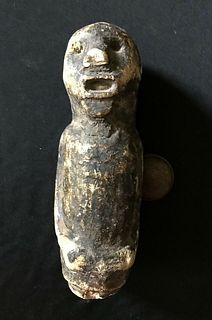Rare 16th C. Indonesian Wood Royal Seat, Carbon Dated
Lot 73a
About Seller
Artemis Fine Arts
686 S Taylor Ave, Ste 106
Louisville, CO 80027
United States
Selling antiquities, ancient and ethnographic art online since 1993, Artemis Gallery specializes in Classical Antiquities (Egyptian, Greek, Roman, Near Eastern), Asian, Pre-Columbian, African / Tribal / Oceanographic art. Our extensive inventory includes pottery, stone, metal, wood, glass and textil...Read more
Estimate:
$30,000 - $40,000
Absentee vs Live bid
Two ways to bid:
- Leave a max absentee bid and the platform will bid on your behalf up to your maximum bid during the live auction.
- Bid live during the auction and your bids will be submitted real-time to the auctioneer.
Bid Increments
| Price | Bid Increment |
|---|---|
| $0 | $25 |
| $300 | $50 |
| $1,000 | $100 |
| $2,000 | $250 |
| $5,000 | $500 |
| $10,000 | $1,000 |
| $20,000 | $2,500 |
| $50,000 | $5,000 |
| $100,000 | $10,000 |
| $200,000 | $20,000 |
About Auction
By Artemis Fine Arts
Jun 27, 2024
Set Reminder
2024-06-27 11:00:00
2024-06-27 11:00:00
America/New_York
Bidsquare
Bidsquare : Connoisseur's Delight Fine Art & Antiquities
https://www.bidsquare.com/auctions/artemis-gallery/connoisseurs-delight-fine-art-antiquities-16181
Classical antiquities, ancient and ethnographic art from cultures encompassing the globe. Artemis Fine Arts info@artemisgallery.com
Classical antiquities, ancient and ethnographic art from cultures encompassing the globe. Artemis Fine Arts info@artemisgallery.com
- Lot Description
Southeast Asia, Indonesia, Borneo, Dayak peoples, ca. 16th century CE (C14 Tested). A carved wooden seat or throne, most certainly for the use of a royal child. With a curved half- basket shape, crescent seat, and on both ends there are drilled holes and carved loops for attaching straps so the seat could be worn like a backpack or carried through the use of attached ropes. The fact that this wood carving has survived for nearly 500 years in this condition is remarkable - the wet, humid climate of Borneo is not conducive for preserving wooden artifacts. This piece was radiocarbon dated to confirm the age. This is a dense and heavy wooden example with ornate carvings, suggesting this served a soci182782s determined what symbols and motifs they could use - full figured beings, as seen carved here, were reserved for the highest classes. Size: 12" L x 7" W x 12" H (30.5 cm x 17.8 cm x 30.5 cm)
Again, we cannot stress enough the age and condition of this piece. Before we had this test, we believed this wood could not be older than 150 to 200 years maximum, so when the test indicated about 500 years ago, we were shocked! For those unfamiliar with carbon dating, in simplest terms the test measures the carbon once a thing has died - for example, this test shows the time period when the tree was cut down (to be clear, this is not the age of the tree!)
The shamans, chieftains, and their close relatives were the aristocrats of Dayak society and only people of this high class could use anthropomorphic carvings to protect themselves, middle classes could use demon or animal depictions, and the lowest could only use geometric abstract designs. Carving the same exact patterns would nullify the power of the spirits, so these baby carriers had to be unique, and while some share similar motifs, none are identical. Siblings or new generations of the same family could use the carrier, but the carrier was not to be used by anyone outside of the family for similar spiritual reasons. Additional objects such as shells, beads, and animal teeth were added to the basket as ornaments to decorate and infuse power and protection; the rattling and noises made by hitting the wood was also believed to drive away evil. While functional transport, these carriers were much more than that and important heirlooms that conveyed the importance and wealth of lineages. To this day very few 3 dimensional objects have been found that where not the end pieces of Sargophagi. Objects of this type have been sold in Europe for $150000-250000 by well known art dealers
This piece has been tested using radiocarbon dating (C-14) analysis and has been found to be ancient and of the period stated. A full report will accompany purchase.
Provenance: private Hawaii, USA collection, acquired from 2000 to 2010
All items legal to buy/sell under U.S. Statute covering cultural patrimony Code 2600, CHAPTER 14, and are guaranteed to be as described or your money back.
A Certificate of Authenticity will accompany all winning bids.
We ship worldwide and handle all shipping in-house for your convenience.
#180726Old losses to throughout, missing areas of the carved panel and chips to rim. Repaired with adhesive. Seat is reattached with visible break lines at the base of the vertical carved panel. Pressure fissures throughout and surface wear. Wood is aged and weathered.Condition
- Shipping Info
-
All shipping is handled in-house for your convenience. Your invoice from Artemis Gallery will include shipping calculation instructions. If in doubt, please inquire BEFORE bidding for estimated shipping costs for individual items.
-
- Buyer's Premium



 EUR
EUR CAD
CAD AUD
AUD GBP
GBP MXN
MXN HKD
HKD CNY
CNY MYR
MYR SEK
SEK SGD
SGD CHF
CHF THB
THB













